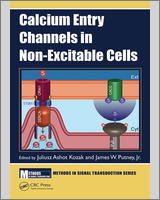This work is licensed under a Creative Commons Attribution-NonCommercial-NoDerivs 3.0 Unported License. To view a copy of this license, visit http://creativecommons.org/licenses/by-nc-nd/3.0/
NCBI Bookshelf. A service of the National Library of Medicine, National Institutes of Health.
Kozak JA, Putney JW Jr., editors. Calcium Entry Channels in Non-Excitable Cells. Boca Raton (FL): CRC Press/Taylor & Francis; 2018.
Virtually every eukaryotic cell expresses at least some type of calcium channel, in the plasma membrane, in intracellular organelles, or typically both. Calcium channels in the plasma membrane have long been of interest to biologists because of their vulnerability to modulation by extracellular factors, with either pathological or therapeutic consequences. Plasma membrane calcium channels are regulated by membrane voltage or by ligands, and in some cases by both. Not surprisingly, voltage-activated channels are generally encountered in cells that depend largely on excitable behavior, for example, muscle and nerve. Calcium channels that are activated by ligands are more broadly distributed but are the exclusive mediators of transmembrane calcium flux in non-excitable cells, for example, blood cells and epithelial cells.
The history of voltage-activated calcium channels is nicely summarized in a review by Richard Tsien [1], dating back to the seminal work of Sidney Ringer at the end of the nineteenth century. In non-excitable cells, the history is more recent, and much of the early work was carried out in smooth muscles, a tissue that expresses both voltage-activated and ligand-gated calcium channels. It might be said that the first mechanistic insights into calcium channels in non-excitable cells came not from studies of the channels themselves but of the initial receptor mechanisms upstream. By far, the most commonly encountered receptor signaling mechanism leading to calcium regulation in non-excitable cells is the receptor-activated phosphatidylinositol 4,5-bisphosphate-directed phospholipase C. Through distinct downstream mechanisms, this initial enzymatic event gives rise to the activation of the two major classes of non-voltage-activated calcium channels, the store-operated channels and TRPC channels, a subgroup of the larger TRP ion channel superfamily. The store-operated channels are activated in response to the depletion of endoplasmic reticulum stores by the phospholipase C product, inositol 1,4,5-trisphosphate, while the TRPCs appear to be activated by phospholipase C-mediated changes in membrane lipid composition. And not surprisingly, there are instances in which the two channels interact and regulate one another. The history of the phospholipase C signaling field is well described by Robert Michell [2], and the histories of the TRP channels and store-operated channels are well described by Craig Montell and Roger Hardie [3,4] and Jim Putney [5], respectively. This volume focuses on physiologically and potentially clinically important channels in non-excitable cells, primarily the store-operated channels and TRP channels, including TRPC channels and the highly Ca2+-selective TRPV5 and TRPV6. In keeping with the theme of this series, there is considerable emphasis on the specific methods required for studying them. This topic was addressed in part in an earlier volume in this series published in 1999 focusing more broadly on calcium signaling [6]. An underlying impetus to produce the current volume comes from the remarkable advances in this field in the past few years. Following the discovery of the first mammalian TRP channels by Zhu and Birnbaumer, the superfamily of TRP channels virtually exploded. After years of false leads, the molecular components of store-operated channels were revealed by the use of modern high-throughput genetic screens, first the calcium sensor STIM, and subsequently the pore-forming store-operated channel subunit, Orai.
In addition to the in-depth analysis of the molecular and physiological aspects of these channels, the reader will no doubt be struck by the breadth of methodological approaches involved in studying them. Enough cannot be said of the contributions of the late Roger Tsien in developing readily available chemical as well as genetically encoded calcium indicators, making possible the measurement of calcium concentration in the cytoplasm and in organelles in real time. Complementing this approach is the use of the techniques of electrophysiology, FRET, optogenetics, and x-ray crystallography, to name a few. Hopefully, this collection will be of use to scientists investigating these important channels, from professor to graduate student, and in academia, government, or industry.
MATLAB® is a registered trademark of The MathWorks, Inc. For product information, please contact:
The MathWorks, Inc.
3 Apple Hill Drive
Natick, MA 01760-2098 USA
Tel: 508-647-7000
Fax: 508-647-7001
E-mail: info@mathworks.com
Web: www.mathworks.com
References
- 1.
- Tsien, R.W. and Barrett, C.F. 2005. A brief history of calcium channel discovery. In Voltage Gated Calcium Channels. G.Zamponi, ed. Plenum Press, New York, pp. 27-47.
- 2.
- Michell, R.H. 1986. Inositol lipids and their role in receptor function: History and general principles. In Phosphoinositides and Receptor Mechanisms. J.W.Putney, ed. Alan R. Liss, Inc., New York, pp. 1-24.
- 3.
- Hardie, R.C. 2011. A brief history of TRP: Commentary and personal perspective. Pflügers Archiv: European Journal of Physiology 461:493-498. [PubMed: 21286746]
- 4.
- Montell, C. 2011. The history of TRP channels, a commentary and reflection. Pflügers Archiv: European Journal of Physiology 461:499-506. [PubMed: 21287198]
- 5.
- Putney, J.W. 2007. Recent breakthroughs in the molecular mechanism of capacitative calcium entry (with thoughts on how we got here). Cell Calcium 42:103-110. [PMC free article: PMC1986648] [PubMed: 17349691]
- 6.
- Putney, J.W. 1999. Calcium Signaling. CRC Press, Boca Raton, FL.
- Preface - Calcium Entry Channels in Non-Excitable CellsPreface - Calcium Entry Channels in Non-Excitable Cells
- Homologene neighbors for GEO Profiles (Select 77148301) (0)GEO Profiles
- Chromosome neighbors for GEO Profiles (Select 11256663) (20)GEO Profiles
- death-associated protein kinase 1 isoform X2 [Homo sapiens]death-associated protein kinase 1 isoform X2 [Homo sapiens]gi|1034664066|ref|XP_016869849.1|Protein
Your browsing activity is empty.
Activity recording is turned off.
See more...
